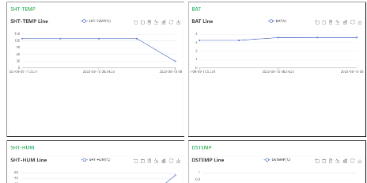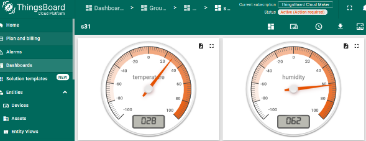DS03A-NB -- NB-IoT Door Sensor User Manual
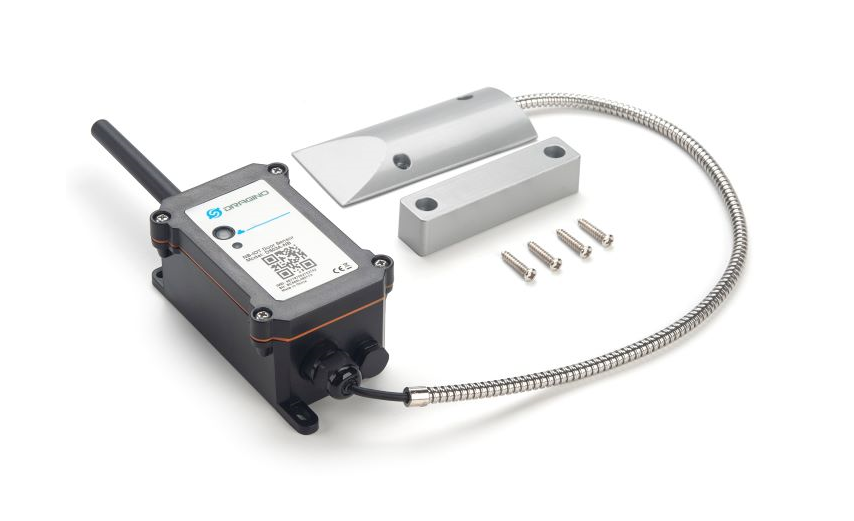
Table of Contents:
- 1. Introduction
- 2. Use DS03A-NB to communicate with IoT Server
- 2.1 Send data to IoT server via NB-IoT network
- 2.2 Payload Types
- 2.3 Test Uplink and Change Update Interval
- 2.4 Multi-Samplings and One uplink
- 2.5 Trggier an uplink by external interrupt
- 2.6 Enable / Disable Alarm
- 2.7 Alarm Base on Timeout
- 2.88 TTRIG1 & TTRIG2 timeout status alarm
- 2.9 Count Mod
- 2.10 Number of channel of door sensors
- 2.11 Clear the open door times and the duration of the last open door
- 2.12 Set the count value of the number of open door
- 2.13 Clock logging (Since firmware version v1.2.1)
- 2.14 Example Query saved historical records
- 2.15 Uplink log query
- 2.16 Scheduled domain name resolution
- 2.17 Set the QoS level
- 2.18 Set the downlink debugging mode(Since firmware v1.3.0)
- 2.19 Domain name resolution settings(Since firmware v1.3.0)
- 3. Configure DS03A-NB
- 4. Battery & Power Consumption
- 5. Firmware update
- 6. FAQ
- 7. Order Info
- 8. Packing Info
- 9. Support
1. Introduction
1.1 What is DS03A-NB NB-IoT Door Sensor
The Dragino DS03A-NB is a NB-IoT Door Sensor for Internet of Things solution. It detects door open/close status and uplinks to IoT server via NB-IoT network. user can see the door status, open duration, open counts in the IoT Server.
The DS03A-NB will send periodically data every 2 hours as well as for each door open/close action. It also counts the door open times and calculates the last door open duration. Users can also disable the uplink for each open/close event, instead, DS03A-NB can count each open event and uplink periodically.
DS03A-NB supports Datalog Feature, it can save the data when there is no NB-IoT network and uplink when network recover.
DS03A-NB has the Open Alarm Feature, user can set this feature so the device will send an alarm if the door has been open for a certain time.
DS03A-NB is designed for outdoor use. It has a weatherproof enclosure and industrial level battery to work in low to high temperatures
DS03A-NB supports different uplink methods including MQTT, MQTTs, UDP, TCP or CoAP for different application requirement, and support uplinks to various IoT Servers.
DS03A-NB supports BLE configure and OTA update which make user easy to use.
DS03A-NB is powered by 8500mAh Li-SOCI2 battery, it is designed for long-term use up to several years.
DS03A-NB has optional built-in SIM card and default IoT server connection version. Which makes it works with simple configuration.
1.2 Features
- NB-IoT Bands: B1/B2/B3/B4/B5/B8/B12/B13/B17/B18/B19/B20/B25/B28/B66/B70/B85 @H-FDD
- Ultra-low power consumption
- Door Open/Close detect
- Door open/close statistics
- Datalog Feature
- Open Alarm Feature
- Probe length: 40cm
- Multiply Sampling and one uplink
- Support Bluetooth v5.1 remote configure and update firmware
- Uplink on periodically
- Downlink to change configure
- 8500mAh Battery for long term use
- Nano SIM card slot for NB-IoT SIM
1.3 Specification
Common DC Characteristics:
- Supply Voltage: 2.5v ~ 3.6v
- Operating Temperature: -40 ~ 85°C
NB-IoT Spec:
NB-IoT Module: BC660K-GL
Support Bands:
- B1 @H-FDD: 2100MHz
- B2 @H-FDD: 1900MHz
- B3 @H-FDD: 1800MHz
- B4 @H-FDD: 2100MHz
- B5 @H-FDD: 860MHz
- B8 @H-FDD: 900MHz
- B12 @H-FDD: 720MHz
- B13 @H-FDD: 740MHz
- B17 @H-FDD: 730MHz
- B18 @H-FDD: 870MHz
- B19 @H-FDD: 870MHz
- B20 @H-FDD: 790MHz
- B25 @H-FDD: 1900MHz
- B28 @H-FDD: 750MHz
- B66 @H-FDD: 2000MHz
- B70 @H-FDD: 2000MHz
- B85 @H-FDD: 700MHz
Battery:
- Li/SOCI2 un-chargeable battery
- Capacity: 8500mAh
- Self Discharge: <1% / Year @ 25°C
- Max continuously current: 130mA
- Max boost current: 2A, 1 second
Power Consumption
- STOP Mode: 10uA @ 3.3v
- Max transmit power: 350mA@3.3v
1.4 Applications

1.5 Sleep mode and working mode
Deep Sleep Mode: Sensor doesn't have any NB-IoT activate. This mode is used for storage and shipping to save battery life.
Working Mode: In this mode, Sensor will work as NB-IoT Sensor to Join NB-IoT network and send out sensor data to server. Between each sampling/tx/rx periodically, sensor will be in IDLE mode), in IDLE mode, sensor has the same power consumption as Deep Sleep mode.
1.6 Button & LEDs
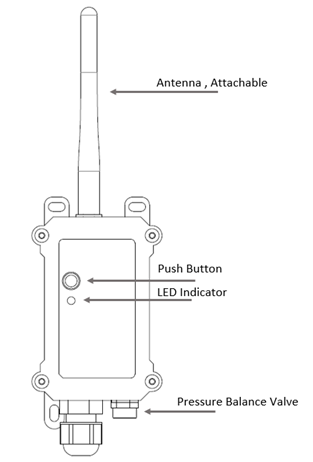
| Behavior on ACT | Function | Action |
|---|---|---|
 1~3s 1~3s | Send an uplink | If sensor has already attached to NB-IoT network, sensor will send an uplink packet, blue led will blink once. |
 >3s >3s | Active Device | Green led will fast blink 5 times, device will enter OTA mode for 3 seconds. And then start to attach NB-IoT network. |
 x5 x5 | Deactivate Device | Red led will solid on for 5 seconds. Means device is in Deep Sleep Mode. |
Note: When the device is executing a program, the buttons may become invalid. It is best to press the buttons after the device has completed the program execution.
1.7 BLE connection
DS03A-NB support BLE remote configure and firmware update.
BLE can be used to configure the parameter of sensor or see the console output from sensor. BLE will be only activate on below case:
- Press button to send an uplink
- Press button to active device.
- Device Power on or reset.
If there is no activity connection on BLE in 60 seconds, sensor will shut down BLE module to enter low power mode.
1.8 Pin Definitions , Switch & SIM Direction
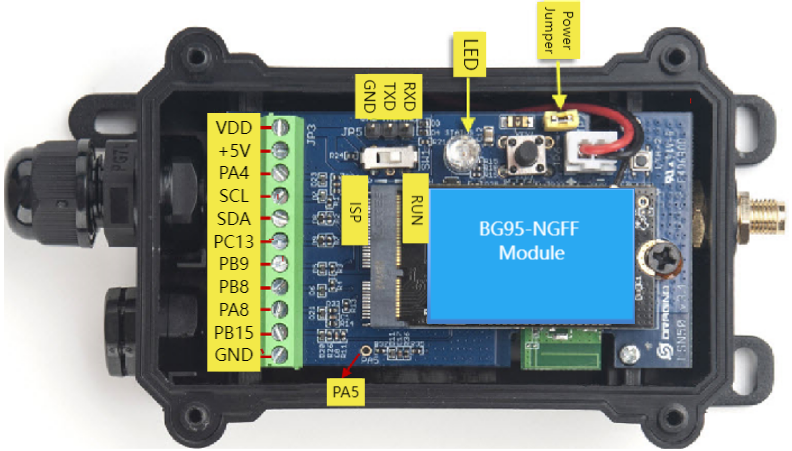
1.8.1 Jumper JP2
Power on Device when put this jumper.
1.8.2 BOOT MODE / SW1
1) ISP: upgrade mode, device won't have any signal in this mode. but ready for upgrade firmware. LED won't work. Firmware won't run.
2) Flash: work mode, device starts to work and send out console output for further debug
1.8.3 Reset Button
Press to reboot the device.
1.8.4 SIM Card Direction
See this link. How to insert SIM Card.
1.9 Mechanical

Probe Mechanical:

1.10 Magnet Distance
- Wood Door: 10mm ~ 30mm
- Iron Door: 30 ~ 45mm
2. Use DS03A-NB to communicate with IoT Server
2.1 Send data to IoT server via NB-IoT network
The DS03A-NB is equipped with a NB-IoT module, the pre-loaded firmware in DS03A-NB will get environment data from sensors and send the value to local NB-IoT network via the NB-IoT module. The NB-IoT network will forward this value to IoT server via the protocol defined by DS03A-NB.
Below shows the network structure:

There are two version: -GE and -1T version of DS03A-NB.
GE Version: This version doesn't include SIM card or point to any IoT server. User needs to use AT Commands to configure below two steps to set DS03A-NB send data to IoT server.
- Install NB-IoT SIM card and configure APN. See instruction of Attach Network.
- Set up sensor to point to IoT Server. See instruction of Configure to Connect Different Servers.
Below shows result of different server as a glance.
| Servers | Dash Board | Comments |
| Node-Red |
| |
| DataCake |
| |
| Tago.IO | ||
| General UDP | Raw Payload. Need Developer to design Dash Board | |
| General MQTT | Raw Payload. Need Developer to design Dash Board | |
| ThingSpeak |
| |
| ThingsBoard |
|
1T Version: This version has 1NCE SIM card pre-installed and configure to send value to ThingsEye. User Just need to select the sensor type in ThingsEyeand Activate DS03A-NB and user will be able to see data in ThingsEye. See here for ThingsEye Config Instruction.
2.2 Payload Types
To meet different server requirement, DS03A-NB supports different payload type.
Includes:
- General JSON format payload. (Type=5)
- HEX format Payload. (Type=0)
- ThingSpeak Format. (Type=1)
- ThingsBoard Format. (Type=3)
User can specify the payload type when choose the connection protocol. Example:
AT+PRO=2,0 // Use UDP Connection & hex Payload
AT+PRO=2,5 // Use UDP Connection & Json Payload
AT+PRO=3,5 // Use MQTT Connection & Json Payload
2.2.1 General Json Format(Type=5)
This is the General Json Format. Payloads in General Json format for single-channel mode and double-channel mode have different byte lengths.
The General Json format payload is as follows:
{"IMEI":"863663062798914","IMSI":"460083513507314","Model":"DS03A-NB","level status":1,"alarm status":0,"door open num":0,"last open time":0,"level status2":1,"alarm status2":0,"door open num2":0,"last open time2":0,"battery":3.22,"signal":14,"time":"2024/11/20 07:08:20","1":[1,0,0,1,0,0,"2024/11/20 06:54:23"],"2":[1,0,0,1,0,0,"2024/11/20 06:39:23"],"3":[0,0,0,8,0,126977,"2024/11/20 05:29:33"],"4":[0,0,0,8,0,323585,"2024/11/20 05:14:33"],"5":[0,0,0,8,0,192513,"2024/11/20 04:59:33"],"6":[0,0,0,8,0,192513,"2024/11/20 04:44:33"],"7":[0,0,0,8,0,192513,"2024/11/20 04:29:33"],"8":[0,0,0,8,0,258049,"2024/11/20 04:14:33"]}

Notice, from above payload:
- level status, alarm status, door open num, last open time, level status2, alarm status2, door open sum2, last open time2, Battery, Signal & time are the value at uplink time.
- Json entry 1 ~ 8 are the last 1 ~ 8 sampling data as specify by AT+CLOCKLOG=1,65535,15,8 Command. Each entry includes (from left to right):
level status, door open num, last open time & Sampling time.
The General Json format payload is as follows:
{"IMEI":"863663062798914","IMSI":"460083513507314","Model":"DS03A-NB","level status":1,"alarm status":0,"door open num":0,"last open time":0,"level status2":1,"alarm status2":0,"door open num2":0,"last open time2":0,"battery":3.21,"signal":19,"time":"2024/11/20 06:31:03","1":[0,0,0,8,0,126977,"2024/11/20 05:29:33"],"2":[0,0,0,8,0,323585,"2024/11/20 05:14:33"],"3":[0,0,0,8,0,192513,"2024/11/20 04:59:33"],"4":[0,0,0,8,0,192513,"2024/11/20 04:44:33"],"5":[0,0,0,8,0,192513,"2024/11/20 04:29:33"],"6":[0,0,0,8,0,258049,"2024/11/20 04:14:33"],"7":[0,200,300,0,16319072,61441,"2024/11/20 02:03:04"],"8":[0,200,300,0,16253640,192513,"2024/11/14 10:00:21"]}

Notice, from above payload:
- level status, alarm status, door open num, last open time, level status2, alarm status2, door open sum2, last open time2, Battery, Signal & time are the value at uplink time.
- Json entry 1 ~ 8 are the last 1 ~ 8 sampling data as specify by AT+CLOCKLOG=1,65535,15,8 Command. Each entry includes (from left to right):
level status, door open num, last open time, level status2, door open sum2, last open time2 & Sampling time.
2.2.2 HEX format Payload(Type=0)
This is the HEX Format. Payloads in HEX format for single-channel mode and double-channel mode have different byte lengths.
The HEX format payload for the single-channel mode is as follows:
f863663062798914f46008351350731412820ca30f010100000000000000673d8fb701000000000000673d8b2301000000000000673d879f01000000000000673d841b0800000001f001673d73bd0800000004f001673d70390800000002f001673d6cb50800000002f001673d69310800000002f001673d65ad

If we use the MQTT client to subscribe to this MQTT topic, we can see the following information when the NB sensor uplink data.

The JSON format payload for the double-channel mode is as follows:
f863663062798914f46008351350731412820c9f110101000000000000000100000000000000673d8c8a0100000000000001000000000000673d8b230100000000000001000000000000673d879f0100000000000001000000000000673d841b0800000001f00100000000000000673d73bd0800000004f00100000000000000673d70390800000002f00100000000000000673d6cb50800000002f00100000000000000673d69310800000002f00100000000000000673d65ad

If we use the MQTT client to subscribe to this MQTT topic, we can see the following information when the NB sensor uplink data.

Version:
These bytes include the hardware and software version.
Higher byte: Specify Sensor Model: 0x12 for DS03A-NB
Lower byte: Specify the software version: 0x82=130, means firmware version 1.3.0
BAT (Battery Info):
Ex1: 0x0dda = 3546mV
Signal Strength:
NB-IoT Network signal Strength.
Ex1: 0x15 = 21
0 -113dBm or less
1 -111dBm
2...30 -109dBm... -53dBm
31 -51dBm or greater
99 Not known or not detectable
Door Status(PA8):
As with level status in JSON format, the level status of the PA8 pin is displayed.
0x00: PA8 pin is high , "Close".
0x01: PA8 pin is low, "Open".
Alarm Status(PA8):
Displays whether the packet is generated by the PA8 pin timeout alarm.
0x00: Normal uplink packet.
0x01: This uplink is generated by PA8 timeout alarm.
door open num(PA8):
Displays the number of times the PA8 pin-connected door sensor is turned on.
Example: 0x00000A(H)=10(D), Open 10 times in total.
last open time(PA8):
Door sensor last open duration, Unit: second.
Example: 0x00012C(H)=300(d), 300 seconds.
Door Status(PA4):
As with level status2 in JSON format, the level status of the PA4 pin is displayed.
0x00: PA4 pin is high, "Close".
0x01: PA4 pin is low, "Open".
Alarm Status(PA4):
Displays whether the packet is generated by the PA4 pin timeout alarm.
0x00: Normal uplink packet.
0x01: This uplink is generated by PA4 timeout alarm.
door open num(PA4):
Displays the number of times the PA4 pin-connected door sensor is turned on.
Example: 0x00000A(H)=10(D), Open 10 times in total.
last open time(PA4):
Door sensor last open duration, Unit: second.
Example: 0x00012C(H)=300(d), 300 seconds.
Timestamp:
Unit Timestamp Example: 650abc40(H) = 1695202368(D)
Put the decimal value into this link(https://www.epochconverter.com)) to get the time.
2.2.3 ThingsBoard Payload(Type=3)
Type3 payload special design for ThingsBoard, it will also configure other default server to ThingsBoard.
The type3 format payload for the single-channel mode is as follows:
{
"topic": "004-NB",
"payload": {
"IMEI": "863663062765285",
"IMSI": "460086859301439",
"Model": "DS03A-NB",
"level status": 1,
"alarm status": 0,
"door open num": 0,
"last open time": 0,
"level status2": 1,
"alarm status2": 0,
"door open num2": 0,
"last open time2": 0,
"battery": 3.33,
"signal": 22,
"time": "2024/12/07 00:56:00",
"1": [0, 5123224, 5340135, "1970/03/01 07:07:05"],
"2": [0, 0, 5339235, "1970/07/14 04:20:16"],
"3": [0, 5123224, 5338335, "1970/03/01 07:07:05"],
"4": [0, 0, 5337435, "1970/07/14 04:20:16"],
"5": [0, 5123224, 5336535, "1970/03/01 07:07:05"],
"6": [0, 0, 5335635, "1970/07/14 04:20:16"],
"7": [0, 5123224, 5334735, "1970/03/01 07:07:05"],
"8": [0, 0, 5333835, "1970/07/14 04:20:16"]
}
}
The type3 format payload for the double-channel mode is as follows:
{
"topic": "004-NB",
"payload": {
"IMEI": "863663062765285",
"IMSI": "460086859301439",
"Model": "DS03A-NB",
"level status": 1,
"alarm status": 0,
"door open num": 0,
"last open time": 0,
"level status2": 1,
"alarm status2": 0,
"door open num2": 0,
"last open time2": 0,
"battery": 3.32,
"signal": 24,
"time": "2024/12/07 00:58:29",
"1": [0, 0, 0, 0, 5123224, 5340135, "1970/03/01 07:07:05"],
"2": [0, 0, 0, 0, 0, 5339235, "1970/07/14 04:20:16"],
"3": [0, 0, 0, 0, 5123224, 5338335, "1970/03/01 07:07:05"],
"4": [0, 0, 0, 0, 0, 5337435, "1970/07/14 04:20:16"],
"5": [0, 0, 0, 0, 5123224, 5336535, "1970/03/01 07:07:05"],
"6": [0, 0, 0, 0, 0, 5335635, "1970/07/14 04:20:16"],
"7": [0, 0, 0, 0, 5123224, 5334735, "1970/03/01 07:07:05"],
"8": [0, 0, 0, 0, 0, 5333835, "1970/07/14 04:20:16"]
}
}

2.2.4 ThingSpeak Payload(Type=1)
This payload meets ThingSpeak platform requirement. It includes eight fields. Form 1~8 are:
Distance, Battery & Signal. This payload type only valid for ThingsSpeak Platform
As below:
field1=Flow value&field2=Battery value&field3=signal value
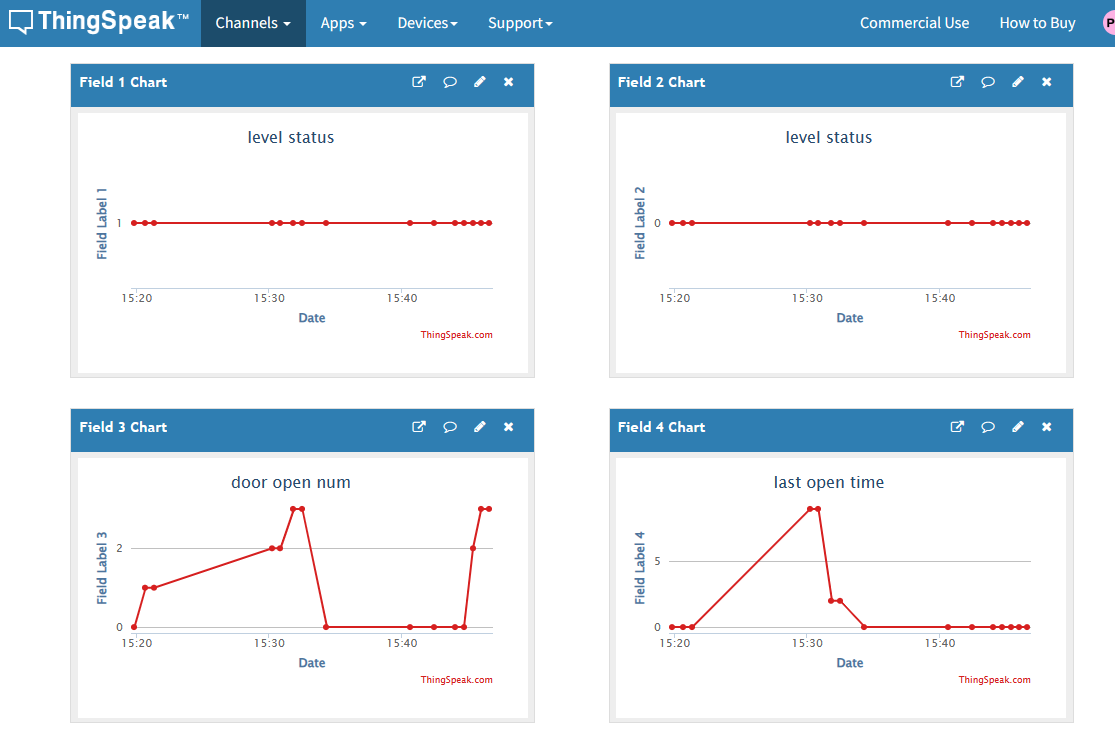
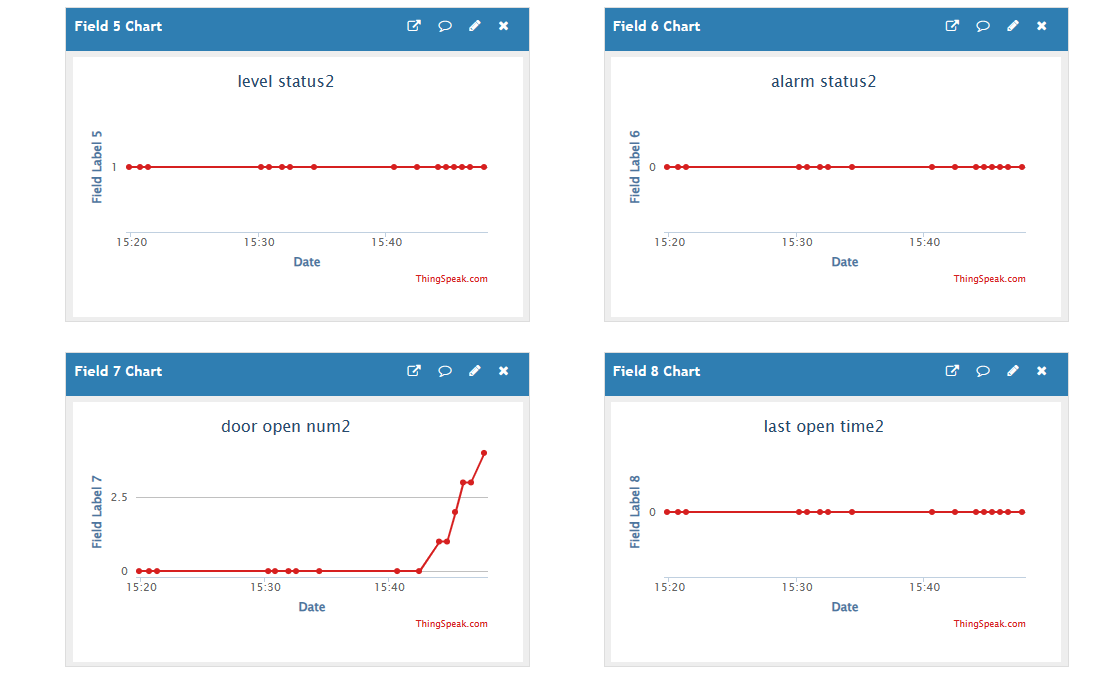
2.3 Test Uplink and Change Update Interval
By default, Sensor will send uplinks every 2 hours
User can use below commands to change the uplink interval.
AT Command: AT+TDC
Example: AT+TDC=7200 // Set Update Interval to 7200 seconds
Downlink Command: 0x01
Format: Command Code (0x01) followed by 3 bytes.
Example: 12 hours= 43200 seconds 43200(D)=0xA8C0(H)
Downlink Payload: 01 00 A8 C0 // AT+TDC=43200, Set Update Interval to 12 hours.
Note: User can also push the button for more than 1 second to activate an uplink.
2.4 Multi-Samplings and One uplink
Notice: The AT+NOUD feature is upgraded to Clock Logging, please refer Clock Logging Feature.
To save battery life, DS03A-NB will sample Water Flow data every 15 minutes and send one uplink every 2 hours. So each uplink it will include 8 stored data + 1 real-time data. They are defined by:
- AT+TR=900 // The unit is seconds, and the default is to record data once every 900 seconds (15 minutes, the minimum can be set to 180 seconds)
- AT+NOUD=8 // The device uploads 8 sets of recorded data by default. Up to 32 sets of record data can be uploaded.
The diagram below explains the relationship between TR, NOUD, and TDC more clearly:
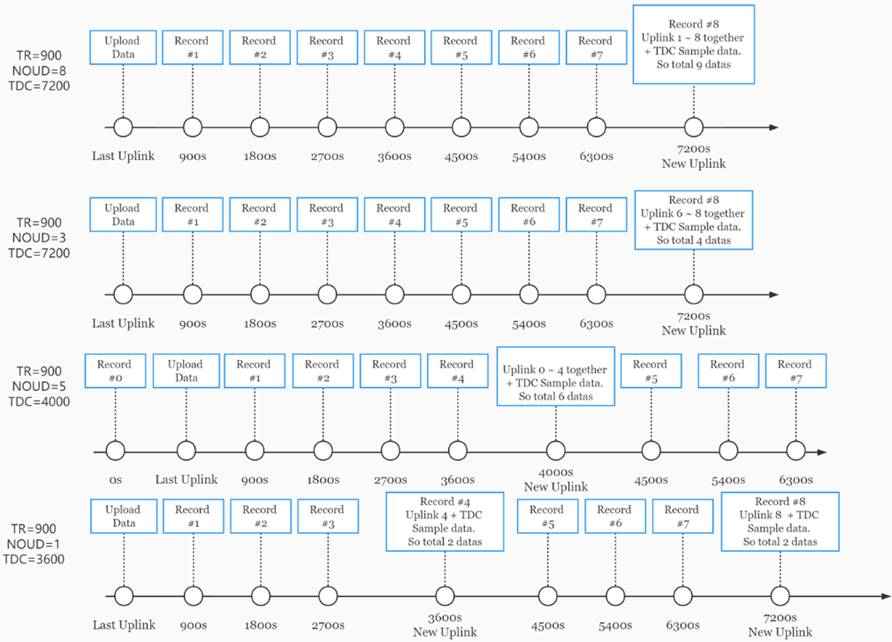
2.5 Trggier an uplink by external interrupt
DS03A-NB has an external trigger interrupt function. Users can use the PB15 pin to trigger the upload of data packets.
AT command:
- AT+INTMOD // Set the trigger interrupt mode
- AT+INTMOD=0 // Disable Interrupt
- AT+INTMOD=1 // Trigger by rising and falling edge
- AT+INTMOD=2 // Trigger by falling edge
- AT+INTMOD=3 // Trigger by rising edge
2.6 Enable / Disable Alarm
Feature: Enable/Disable Alarm for open/close event. Default value 0.
AT Command:
| Command Example | Function | Response |
| AT+DISALARM=1 | End node will only send packets in TDC time. | OK |
| AT+DISALARM=0 | End node will send packets in TDC time or status change for door sensor | OK |
Downlink Command:
0xA7 01 // Same As AT+DISALARM=1
0xA7 00 // Same As AT+DISALARM=0
2.7 Alarm Base on Timeout
DS03A-NB can monitor the timeout for a status change, this feature can be used to monitor some events such as door opening too long etc. Related Parameters are:
Keep Status: Status to be monitor
Keep Status = 1: Monitor Close to Open event
Keep Status = 0: Monitor Open to Close event
Keep Time: Timeout to send an Alarm
Range 0 ~ 65535(0xFFFF) seconds.
If keep time = 0, Disable Alarm Base on Timeout feature.
If keep time > 0, device will monitor the keep status event and send an alarm when status doesn't change after timeout.
Downlink Command
Command: 0xA9 aa bb cc dd
A9: Command Type Code
aa: 01:TTRIG1; 02:TTRIG2
bb: status to be monitored
cc dd: timeout.
1) AT+TTRIG1 : (PA8 of pin)
AT Command to configure:
AT+TTRIG1=1,30 --> When the Keep Status change from close to open, and device remains in open status for more than 30 seconds. DS03A-NB will send an uplink packet, the Alarm1 bit(the second bit of 1st byte of payload) on this uplink packet is set to 1.
AT+TTRIG1=0,30 --> When the Keep Status change from open to close, and device remains in open status for more than 30 seconds. DS03A-NB will send an uplink packet, the Alarm1 bit (the second bit of 1st byte of payload) on this uplink packet is set to 1.
AT+TTRIG1=0,0 --> Default Value, disable timeout Alarm.
Downlink Command to configure:
If user send 0xA9 01 01 00 1E: equal to AT+TTRIG1=1,30 or 0xA9 01 00 00 00: Equal to AT+TTRIG1=0,0.
2) AT+TTRIG2 : (PA4 of pin,need to use AT+TTRCHANNEL=2)
AT Command to configure:
AT+TTRIG2=1,30 --> When the Keep Status change from close to open, and device remains in open status for more than 30 seconds. DS03A-NB will send an uplink packet, the Alarm2 bit (the second bit of 12st byte of payload) on this uplink packet is set to 1.
AT+TTRIG2=0,30 --> When the Keep Status change from open to close, and device remains in open status for more than 30 seconds. DS03A-NB will send an uplink packet, the Alarm2 bit (the second bit of 12st byte of payload) on this uplink packet is set to 1.
AT+TTRIG2=0,0 --> Default Value, disable timeout Alarm.
Downlink Command to configure:
If user send 0xA9 02 00 00 1E: equal to AT+TTRIG2=0,30 or 0xA9 02 00 00 00: Equal to AT+TTRIG2=0,0.
2.88 TTRIG1 & TTRIG2 timeout status alarm
It needs to be used with AT+TTRIG1 or AT+TTRIG2. When TTRIG1 or TTRIG2 times out and causes an alarm, and the status does not change subsequently, an alarm packet will be sent at the alarm interval.
AT Command:
| Command Example | Function | Response |
|---|---|---|
AT+TTRALARM=0 | disable continuous alarm | OK |
AT+TTRALARM=60 | The alarm interval is 60 minutes (unit: minutes) | OK |
Downlink Command:
Example: 0C aa => AT+TTRALARM= aa
2.9 Count Mod
Feature: Manually set the count mode.
AT Command:
| Command Example | Function | Response |
|---|---|---|
AT+COUNTMOD=0 | the count value keeps accumulating mode | OK |
AT+COUNTMOD=1 | the count value will be reset after each TDC time(Last Close Duration Reset after each uplink) | OK |
Downlink Command:
Example: 0B aa => AT+COUNTMOD = second byte
2.10 Number of channel of door sensors
Feature: Set the number of door sensor channels.
AT Command:
| Command Example | Function | Response |
|---|---|---|
AT+TTRCHANNEL=1 | Set as single channel, only use PA8 pin as interrupt pin. | OK |
AT+TTRCHANNEL=2 | Set as dual channel, use PA8 pin and PA4 pin as interrupt pin. | OK |
Downlink Command:
Example: 0D aa => AT+TTRCHANNEL = second byte
2.11 Clear the open door times and the duration of the last open door
AT Command:
| Command Example | Function | Response |
|---|---|---|
| AT+CLRC | clear the open door times and the duration of the last open door. | OK |
Downlink Command:0xA6 01
The sensor will clear the open door times and the duration of the last open door.
2.12 Set the count value of the number of open door
AT Command:
| Command Example | Function | Response |
|---|---|---|
AT+SETCNT=1,100 | Set the open door times of PA8 pin to 100 times. | OK |
| AT+SETCNT=1,0 | Clear the open door times of PA8 pin. | OK |
AT+SETCNT=2,50 | Set the open door times of PA4 pin to 100 times. | OK |
Downlink Command:
0xA6 01 00 00 64 ==> AT+SETCNT=1,100
0xA6 01 00 00 00 ==> AT+SETCNT=1,0
0xA6 02 00 00 32 ==> AT+SETCNT=2,50
2.13 Clock logging (Since firmware version v1.2.1)
Sometimes when we deploy lots of end nodes in field. We want all sensors sample data at the same time, and upload these data together for analyze. In such case, we can use clock loging feature.
We can use this command to set the start time of data recording and the time interval to meet the requirements of the specific collection time of data.
- AT Command: AT+CLOCKLOG=a,b,c,d
a: 0: Disable Clock logging. 1: Enable Clock Logging
b: Specify First sampling start second: range (0 ~ 3599, 65535) // Note: If parameter b is set to 65535, the log period starts after the node accesses the network and sends packets.
c: Specify the sampling interval: range (0 ~ 255 minutes)
d: How many entries should be uplink on every TDC (max 32)
Note: To disable clock recording, set the following parameters: AT+CLOCKLOG=1,65535,0,0
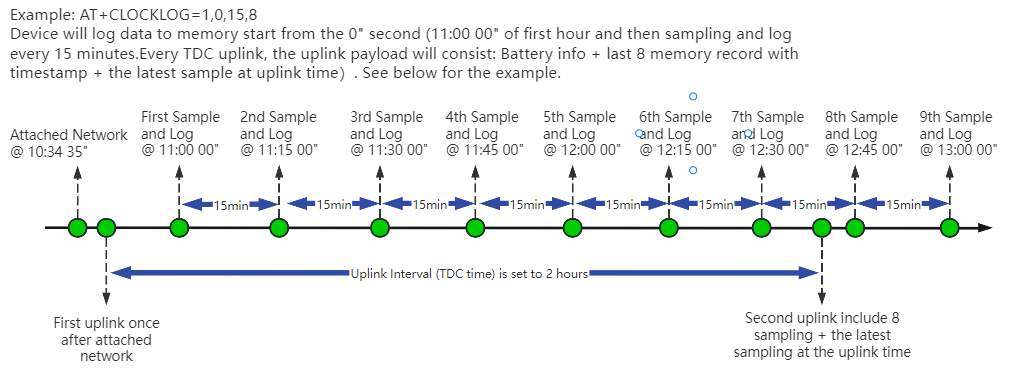
Example:
AT+CLOCKLOG=1,65535,1,5
After the node sends the first packet, data is recorded to the memory at intervals of 1 minute. For each TDC uplink, the uplink load will include: battery information + the last 5 memory records (payload + timestamp).
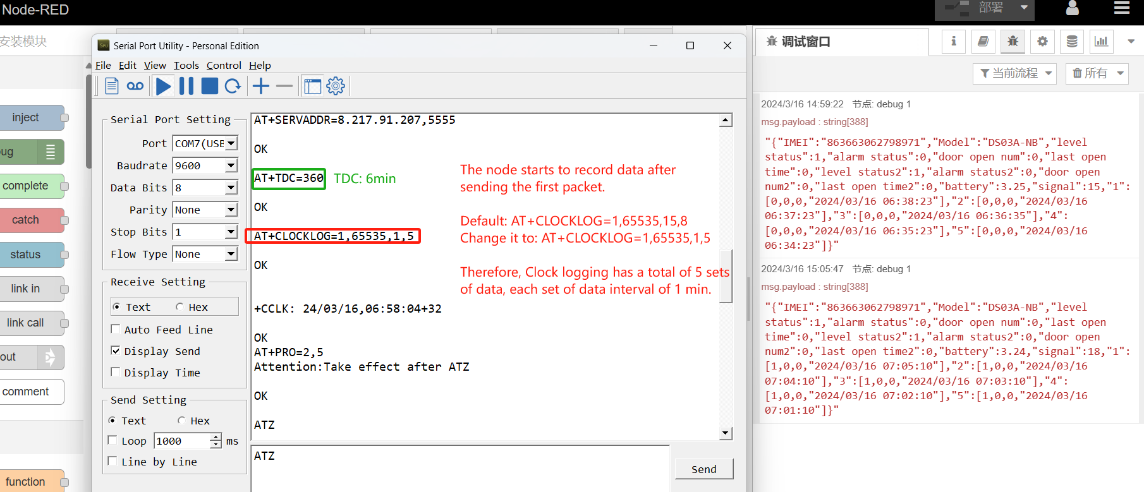
Note: Users need to synchronize the server time before configuring this command. If the server time is not synchronized before this command is configured, the command takes effect only after the node is reset.
- Downlink Command: 0x0A
Format: Command Code (0x0A) followed by 5 bytes.
- Example 1: Downlink Payload: 0A01FFFF0F08 // Set SHT record time: AT+CLOCKLOG=1,65535,15,8
- Example 1: Downlink Payload: 0A0104B00F08 // Set SHT record time: AT+CLOCKLOG=1,1200,15,8
Note: When entering the downlink payload, there must be no Spaces between bytes.
2.14 Example Query saved historical records
- AT Command: AT+CDP
This command can be used to search the saved history, recording up to 32 groups of data, each group of historical data contains a maximum of 100 bytes.
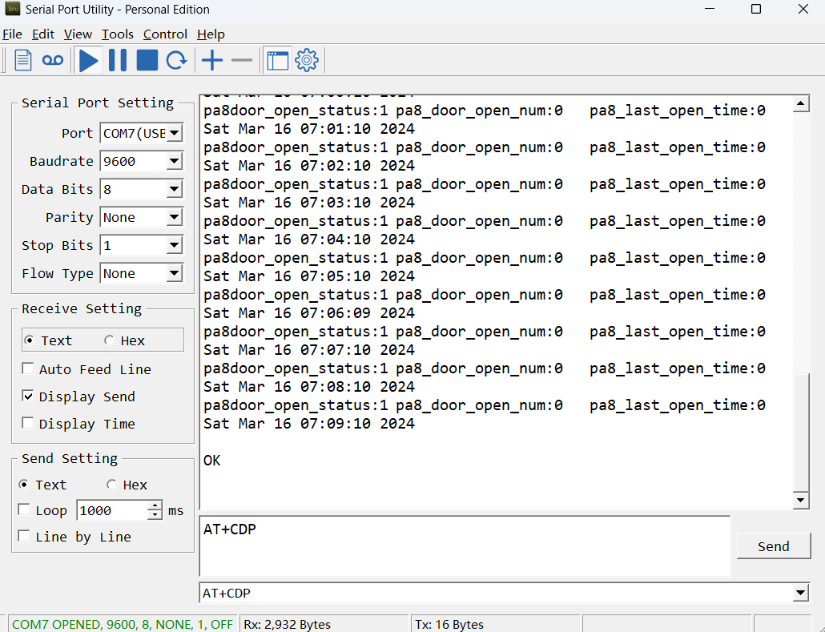
2.15 Uplink log query
- AT Command: AT+GETLOG
This command can be used to query upstream logs of data packets.
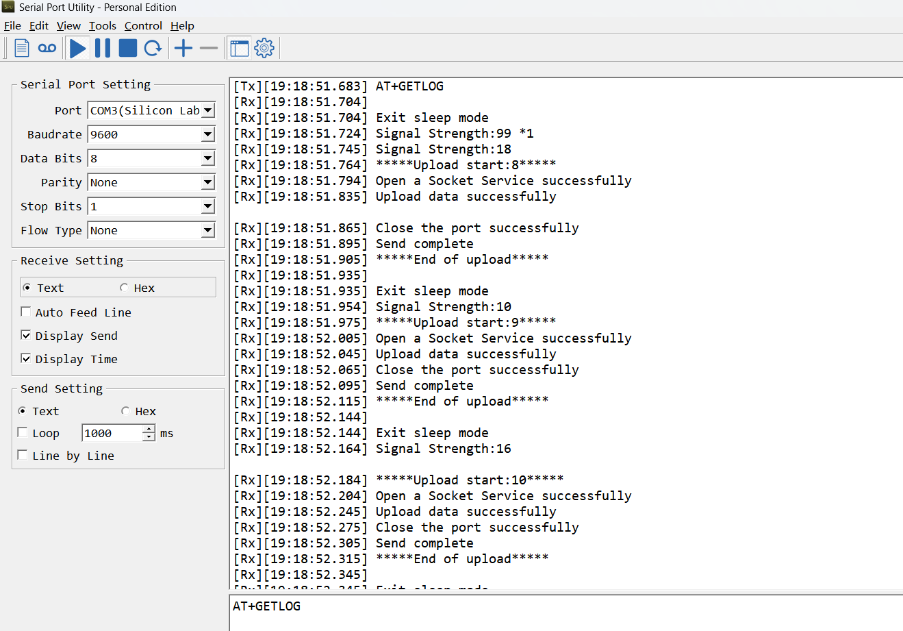
2.16 Scheduled domain name resolution
This command is used to set up scheduled domain name resolution.
AT command:
- AT+DNSTIMER=XX // Unit: hour
After setting this command, domain name resolution will be performed regularly.
2.17 Set the QoS level
This command is used to set the QoS level of MQTT.
AT command:
- AT+MQOS=xx // 0~2
Downlink Command: 0x07
Format: Command Code (0x07) followed by 1 byte.
Ex1: Downlink payload: 0x0700 // AT+MQOS=0
Ex2: Downlink payload: 0x0701 // AT+MQOS=1
2.18 Set the downlink debugging mode(Since firmware v1.3.0)
Feature: Set the conversion between the standard version and 1T version downlinks.
AT command: AT+DOWNTE
| Command Example | Function/Parameters | Response/Explanation |
|---|---|---|
| AT+DOWNTE=? | Get current Settings | 0,0 (default) |
AT+DOWNTE=a,b | a: Set the conversion between the downlink of the standard version and 1T version | 0: Set the downlink of the standard version. |
| b: Enable/Disable downlink debugging | 0: Disable downlink debugging mode. |
Example:
- AT+DOWNTE=0,1 // Set to standard version downlink, and enable downlink debugging.
- AT+DOWNTE=1,1 // Set to 1T version downlink, and enable downlink debugging.
Downlink Command:
No downlink commands for feature
2.19 Domain name resolution settings(Since firmware v1.3.0)
Feature: Set dynamic domain name resolution IP.
AT command: AT+BKDNS
| Command Example | Function/Parameters | Response/Explanation |
|---|---|---|
AT+BKDNS=? | Get current Settings | 0,0,NULL (default) |
AT+BKDNS=a,b,c | a: Enable/Disable dynamic domain name resolution. | 1: Disable dynamic domain name update. The ip address will be saved after the domain name is resolved, if the next domain name resolution fails, the last saved ip address will be used. 2: Enable dynamic domain name update. The ip address will be saved after domain name resolution, if the next domain name resolution fails, the last saved ip address will be used, and the domain name resolution will be updated regularly according to the time set by the customer. |
| b: Set the time to update the domain name resolution at regular intervals. | Unit: hour | |
c: Set the IP address manually. | The format is the same as AT+SERVADDR. |
Example:
- AT+BKDNS=1,0 // Dynamic domain name resolution is disabled.
- AT+BKDNS=2,1 // The dynamic domain name resolution function is enabled and the automatic update time is set to 1 hour.
- AT+BKDNS=2,4,3.69.98.183,1883 // The dynamic domain name resolution function is enabled and the automatic update time is set to 4 hour, and manually set the ip address, if the domain name failed to resolve, it will directly use this ip to communicate. When the next domain name resolution is successful, it will be updated to the ip address of the successful resolution.
Downlink Command:
No downlink commands for feature
3. Configure DS03A-NB
3.1 Configure Methods
DS03A-NB supports below configure method:
- AT Command via Bluetooth Connection (Recommended): BLE Configure Instruction.
- AT Command via UART Connection : See UART Connection.
3.2 Serial Access Password
After the Bluetooth or UART connection is successful, use the Serial Access Password to enter the AT command window.
The label on the box of the node will print the initial password: AT+PIN=xxxxxx, and directly use the six-digit password to access the AT instruction window.
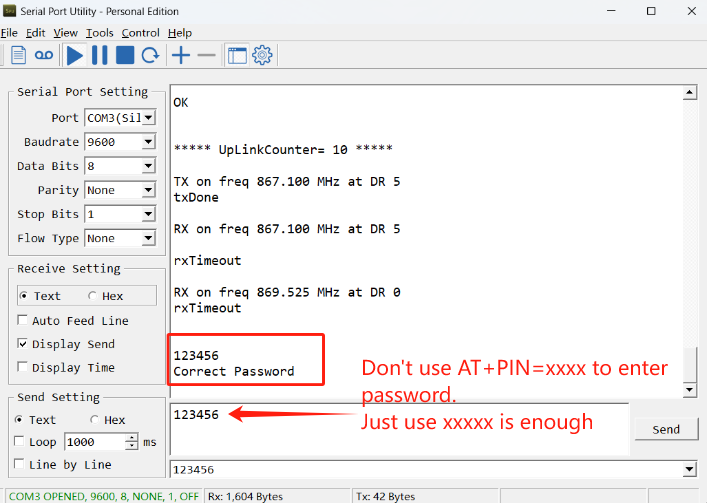
If you need to change the password, use AT+PWORD=xxxxxx (6 characters), NB nodes only support lowercase letters.

Note: After entering the command, you need to add a line break, and you can also set automatic line breaks in the Bluetooth tool or UART connection tool.

3.3 AT Commands Set
AT+<CMD>? : Help on <CMD>
AT+<CMD> : Run <CMD>
AT+<CMD>=<value> : Set the value
AT+<CMD>=? : Get the value
General Commands
AT : Attention
AT? : Short Help
ATZ : MCU Reset
AT+TDC : Application Data Transmission Interval
AT+CFG : Print all configurations
AT+CFGMOD : Working mode selection
AT+DEUI : Get or set the Device ID
AT+INTMOD : Set the trigger interrupt mode
AT+5VT : Set extend the time of 5V power
AT+PRO : Choose agreement
AT+RXDL : Extend the sending and receiving time
AT+DNSCFG : Get or Set DNS Server
AT+GETSENSORVALUE : Returns the current sensor measurement
AT+NOUD : Get or Set the number of data to be uploaded
AT+CDP : Read or Clear cached data
AT+SERVADDR : Server Address
MQTT Management
AT+CLIENT : Get or Set MQTT client
AT+UNAME : Get or Set MQTT Username
AT+PWD : Get or Set MQTT password
AT+PUBTOPIC : Get or Set MQTT publish topic
AT+SUBTOPIC : Get or Set MQTT subscription topic
Information
AT+FDR : Factory Data Reset
AT+PWORD : Serial Access Password
AT+LDATA : Get the last upload data
AT+CDP : Read or Clear cached data
4. Battery & Power Consumption
DS03A-NB use ER26500 + SPC1520 battery pack. See below link for detail information about the battery info and how to replace.
Battery Info & Power Consumption Analyze .
5. Firmware update
User can change device firmware to::
- Update with new features.
- Fix bugs.
Firmware and changelog can be downloaded from : Firmware download link
Methods to Update Firmware:
- (Recommended way) OTA firmware update via BLE: Instruction.
- Update through UART TTL interface : Instruction.
6. FAQ
6.1 How can I access the BC660K-GL AT Commands?
User can access to BC660K-GL directly and send AT Commands.
6.2 How to configure the certificate?
User can can refer to this description to configure the certificate.
7. Order Info
Part Number: DS03A-NB-XX
XX:
- GE: General version ( Exclude SIM card)
- 1T: with 1NCE * 10 years 500MB SIM card and Pre-configure to ThingsEye server
8. Packing Info
Package Includes:
- DS03A-NB NB-IoT Door sensor x 1
- External antenna x 1
Dimension and weight:
- Device Size: 13.0 x 5 x 4.5 cm
- Device Weight: 150g
- Package Size / pcs : 14.0 x 8x 5 cm
- Weight / pcs : 180g
9. Support
- Support is provided Monday to Friday, from 09:00 to 18:00 GMT+8. Due to different timezones we cannot offer live support. However, your questions will be answered as soon as possible in the before-mentioned schedule.
- Provide as much information as possible regarding your enquiry (product models, accurately describe your problem and steps to replicate it etc) and send a mail to Support@dragino.cc.

